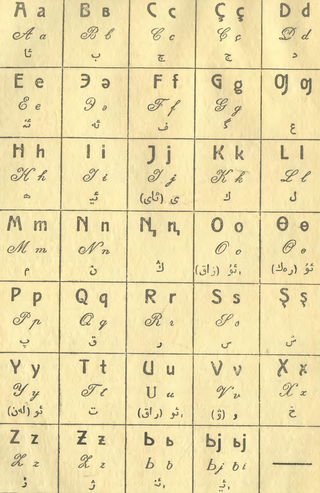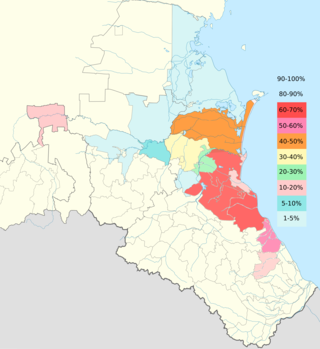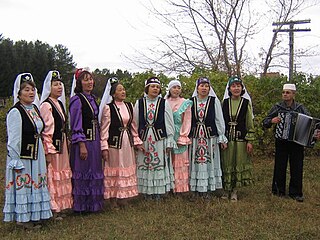
The Tatars, formerly also spelled Tartars, is an umbrella term for different Turkic ethnic groups bearing the name "Tatar" across Eastern Europe and Asia.

Uzbek is a Karluk Turkic language spoken by Uzbeks. It is the official and national language of Uzbekistan and formally succeeded Chagatai, an earlier Karluk language also known as Turki, as the literary language of Uzbekistan in the 1920s.

The Bashkirs or Bashkorts are a Turkic ethnic group indigenous to Russia. They are concentrated in Bashkortostan, a republic of the Russian Federation and in the broader historical region of Badzhgard, which spans both sides of the Ural Mountains, where Eastern Europe meets North Asia. Smaller communities of Bashkirs also live in the Republic of Tatarstan, the oblasts of Perm Krai, Chelyabinsk, Orenburg, Tyumen, Sverdlovsk and Kurgan and other regions in Russia; sizeable minorities exist in Kazakhstan and Uzbekistan.

Tatar is a Turkic language spoken by the Volga Tatars mainly located in modern Tatarstan, as well as Siberia and Crimea.

Chagatai, also known as Turki, Eastern Turkic, or Chagatai Turkic, is an extinct Turkic language that was once widely spoken across Central Asia. It remained the shared literary language in the region until the early 20th century. It was used across a wide geographic area including western or Russian Turkestan, Eastern Turkestan, Crimea, the Volga region, etc. Chagatai is the ancestor of the Uzbek and Uyghur languages. Turkmen, which is not within the Karluk branch but in the Oghuz branch of Turkic languages, was nonetheless heavily influenced by Chagatai for centuries.

Bashkir or Bashkort is a Turkic language belonging to the Kipchak branch. It is co-official with Russian in Bashkortostan. It is spoken by around 750,000 native speakers in Russia, as well as in Belarus, Kazakhstan, Uzbekistan and other neighboring post-Soviet states, and among the Bashkir diaspora. It has three dialect groups: Southern, Eastern and Northwestern.

The Chuvash people are a Turkic ethnic group, a branch of the Oğurs, inhabiting an area stretching from the Idel-Ural region to Siberia.

Cuman or Kuman was a West Kipchak Turkic language spoken by the Cumans and Kipchaks; the language was similar to today's various languages of the West Kipchak branch. Cuman is documented in medieval works, including the Codex Cumanicus, and in early modern manuscripts, like the notebook of Benedictine monk Johannes ex Grafing. It was a literary language in Central and Eastern Europe that left a rich literary inheritance. The language became the main language of the Golden Horde.

Jaꞑalif, Yangalif or Yañalif is the first Latin alphabet used during the latinisation in the Soviet Union in the 1930s for the Turkic languages. It replaced the Yaña imlâ Arabic script-based alphabet in 1928, and was replaced by the Cyrillic alphabet in 1938–1940. After their respective independence in 1991, several former Soviet states in Central Asia switched back to Latin script, with slight modifications to the original Yañalif.

Kumyk is a Turkic language spoken by about 520,000 people, mainly by the Kumyks, in the Dagestan, North Ossetia and Chechen republics of the Russian Federation. Until the 20th century Kumyk was the lingua franca of the Northern Caucasus.

Siberian Tatars or Sibirs are the indigenous Turkic-speaking population of the forests and steppes of Western Siberia, originating in areas stretching from somewhat east of the Ural Mountains to the Yenisey River in Russia. The Siberian Tatars call themselves Yerle Qalıq, to distinguish themselves from more recent Volga Tatar immigrants to the region.
The Mongol invasion of Volga Bulgaria lasted from 1223 to 1236. The Bulgar state, centered in lower Volga and Kama, was the center of the fur trade in Eurasia throughout most of its history. Before the Mongol conquest, Russians of Novgorod and Vladimir repeatedly looted and attacked the area, thereby weakening the Bulgar state's economy and military power. The latter ambushed the Mongols in the later 1223 or in 1224. Several clashes occurred between 1229–1234, and the Mongol Empire conquered the Bulgars in 1236.
Krymchak is a moribund Turkic language spoken in Crimea by the Krymchak people. The Krymchak community was composed of Jewish immigrants who arrived from all over Europe and Asia and who continuously added to the Krymchak population. The Krymchak language, as well as culture and daily life, was similar to Crimean Tatar, the peninsula's majority population, with the addition of a significant Hebrew influence.

The Volga Tatars or simply Tatars, and occasionally by the historical Turko-Tatars, are a Kipchak-Bulgar Turkic ethnic group native to the Volga-Ural region of western Russia. They are subdivided into various subgroups. Volga Tatars are the second-largest ethnic group in Russia after ethnic Russians. Most of them live in the republics of Tatarstan and Bashkortostan. Their native language is Tatar, a language of the Turkic language family. The predominant religion is Sunni Islam, followed by Orthodox Christianity.

Yaña imlâ was a modified variant of Arabic script that was in use for the Tatar language between 1920 and 1927. The orthographical reform modified İske imlâ, abolishing excess Arabic letters, adding letters for short vowels e, ı, ö, o. Yaña imlâ made use of "Arabic Letter Low Alef" ⟨ࢭ⟩ to indicate vowel harmony. Arguably, Yaña imlâ had as its goal the accommodation of the alphabet to the actual Tatar pronunciation.
Karakhanid, also known as Khaqani Turkic, was a Turkic language developed in the 11th century during the Middle Turkic period under the Kara-Khanid Khanate. It has been described as the first literary Islamic Turkic language. It is sometimes classified under the Old Turkic category, rather than Middle Turkic, as it is contemporary to the East Old Turkic languages of Orkhon Turkic and Old Uyghur. Eastern Middle Turkic languages, namely Khorezmian Turkic and later Chagatai are descendants of the Karakhanid language.

The Mishar Tatars, previously known as the Meshcheryaki (мещеряки), are the second largest subgroup of the Volga Tatars, after the Kazan Tatars. Traditionally, they have inhabited the middle and western side of Volga, including the nowadays Mordovia, Tatarstan, Bashkortostan, Ryazan, Penza, Ulyanovsk, Orenburg, Nizhny Novgorod and Samara regions of Russia. Many have since relocated to Moscow. Mishars also comprise the majority of Finnish Tatars and Tatars living in other Nordic and Baltic countries.
The Bashkir alphabet is a writing system used for the Bashkir language. Until the mid-19th century, Bashkir speakers wrote in the Volga Türki literary language using the Arabic script. In 1869, Russian linguist Mirsalikh Bekchurin published the first guide to Bashkir grammar, and the first Cyrillic Bashkir introductory book was published by Vasily Katarinsky in Orenburg in 1892. Latinisation was first discussed in June 1924, when the first draft of the Bashkir alphabet using the Latin script was created. More reforms followed, culminating in the final version in 1938.
The Mamluk-Kipchak language was a Kipchak language that was spoken in Egypt and Syria during the Mamluk Sultanate period.














